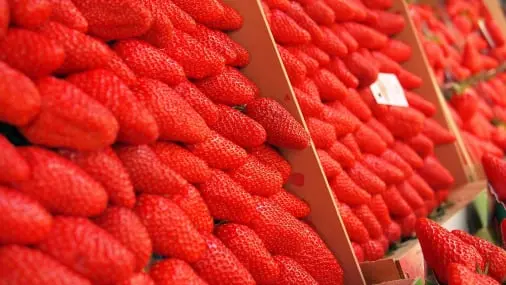RFID fresh produce traceability:
RFID fresh produce traceability inventory pallet control: Automatically track fresh produce (apples, onion, potato, citrus) when moved from warehouse/cool room. Inexpensive solution uses low cost hardware with almost zero installation costs.

RFID fresh produce Traceability during production & packing
View Traceability App Specifications.
RFID Fresh produce inventory pallet control
RFID Fresh produce inventory pallet control
Zero waste
Stock rotation and expiry can be eliminated through automatic alerts, automatic FIFO enforcement, staff are guided to the exact location of fresh produce that must be processed or sold first.
Zero effort
Simply pick up a pallet/bin/bag and move it. RFID by farmsoft automatically tracks fresh produce inventory movement, updates its location, and flashes an alert on your tablet. Select an order, load pallets onto truck..… RFID by farmsoft automatically adds the pallets to the
order / invoice. Tip a bin into a batch or add pallet to a batch, its auto added to the batch. If you have your own trucks, you can RFID tag them; when you load an order farmsoft RFID will know which truck you have loaded.
Zero errors
Ever put the wrong pallet onto a truck, only to discover the error and must unload? Ever sent the wrong pallet across the country only to have to pay for it to be returned? Never again! RFID by farmsoft will alert you the second you pick up a pallet that doesn’t match current order. Make fresh produce load outs faster, and 100% accurate.

RFID fresh produce packhouse hygiene checklist for food safety
The ability to track and trace complete information at item level in an efficient and trustworthy manner is becoming more and more important for companies, mainly due to the increased consumer concern over the safety and the quality of the purchased products. This is even more true for companies involved in the fresh vegetables supply chain, because the delicacy of fresh-cut products requires all stakeholders to organize their business processes as efficiently as possible to guarantee the end customers the highest quality products. The shift from quantity-oriented agriculture to new emphasis on products quality and people’s safety has placed new demands for the development and adoption of traceable supply chains. Traceability represents the ability to capture, collect, and store information related to all processes in the supply chain in a manner that provides guarantee to the consumer and other stakeholders on the origin, location and life history of a product. In particular, the adoption of an effective gapless traceability system, in the fresh vegetables supply chain, could enable companies to (i) detect warnings associated with product contaminations quickly and accurately, and (ii) optimize their main production processes in order to reduce cultivation costs and to ensure, at the same time, production optimization. Furthermore, an efficient traceability system represents a fundamental tool for people with special needs, such as patients affected by multiple intolerances [1], who struggle every day to perform elementary actions, such as the choice of food, because of the adverse reactions that particular components could cause if taken.
How RFID technology can help increase confidence in food safety
Hand holding an RFID
KEYWORDS coronavirus and food safety / food safety trends / GS1 / RFID tags / RFID technology / tracking solutions
Order Reprints
Prior to the COVID-19 pandemic, conscious consumerism was on the rise in a big way, forcing a shift in the way food supply chains function. Consumers want supply chain transparency, robust product information, the assurance of food safety and swift action when a recall occurs.
Now, in the age of pantry-loading, fast-food delivery and outdoor dining, satisfying a deeper need for information will be the key to securing consumer confidence and trust in our new pandemic-influenced reality. Core to delivering on what consumers want is enabling improved food traceability.

RFID fresh produce Traceability management best practices
Recognizing the need to improve supply chain visibility and, ultimately, traceability, foodservice companies are beginning to explore the use of radio frequency identification (RFID) technology to trace products throughout the supply chain and gain operational efficiencies. RFID-enabled efficiencies can cut labor costs by as much as 50% in the food supply chain, according to Avery Dennison. With equipment and label costs falling further each year as adoption ramps up (labels cost around five cents each now compared with 25 cents in 2008), many companies believe the investment can deliver significant returns.
RFID in the supply chain is nothing new—it has been used in retail for more than a decade, particularly in the apparel industry, to improve inventory visibility and gain fulfillment efficiencies. Levi’s, Nike, Macy’s and Target are among the most vocal supporters of RFID and have used it to help make their supply chains more agile. They’ve cited RFID as a foundational technology necessary to support e-commerce.
Learning from the successful implementations of RFID in retail, members of the Foodservice GS1 US Standards Initiative, a collaborative group of foodservice supply chain partners, are testing RFID to gain similar efficiencies and better serve their guests. RFID tags and readers add efficiency to the supply chain because they do not require the same line-of-sight scanning as barcodes. They can also enable the collection of information in real time and the ability to pinpoint where products are across the supply chain. Plus, in a world of prolonged social distancing due to COVID-19, there exists an opportunity to leverage RFID technology to create more contactless options to procure food.

RFID fresh produce Supplier Traceability Management
RFID and Traceability
Looking toward the future of traceability, food companies are going to need to align on a common way to communicate product data to close any gaps in information in the supply chain. Global GS1 Standards play a key role in traceability as well as RFID implementations—having consistency in data exchange and product and location identification is critical to tracing products from farm to fork.
Good traceability starts at the source, where globally unique identifiers like Global Trade Item Numbers (GTINs) should be used on products in lieu of proprietary numbers that could create confusion across external systems. GTINs can be encoded into RFID tags along with additional product information, similar to how they are encoded into barcodes. In the food industry, case-level barcodes have traditionally served as the key point where information is connected to the flow of the product. Not only can RFID can help companies capture more data efficiently while products are in transit, it can streamline and validate the loading and receiving processes. Extended data such as batch number, lot number and expiration date are already becoming must-have information in the supply chain—RFID has the potential to take this further as tags can hold far more data than barcodes. This can enable full product provenance and enhance visibility through greater automation.
RFID and Inventory Visibility
When RFID tags are used, all supply chain partners that have RFID readers can enhance their real-time view of the product as it moves from stop to stop. Operators can then leverage RFID readers in their facilities to understand what they have available to sell. According to the Auburn University RFID Lab, RFID can raise inventory accuracy significantly, from 63% to 95%.
RFID is valuable for a foodservice operation simply because it reduces inventory uncertainty. For example, if an RFID reader is placed in a restaurant’s refrigerator, the operator will automatically know when there is a spike in a particular item being used, because the reader automates the transmission of inventory data. The operator sees in real time how much product is available to fulfill consumer demand. From a food safety perspective, RFID can play a role in helping operators intercept potentially harmful food before it reaches their guests because they have access to updated intelligence on what’s in stock and can take precautionary measures faster.
There are some inventory management differences between the way RFID is used in retail and how it may be used in foodservice. In foodservice, tags will be applied at the case level, instead of to individual items like in retail, simply due to the nature of how products are stored and transported. For example, there is no benefit to individually tagging a beef patty in the same way that there is in tagging a t-shirt in retail.
RFID and Our Contactless Future
RFID could be a key tool in our new normal, as it reduces the reliance on manual processes. For example, warehouse staff can more appropriately distance if RFID is used for cycle counts, and they can be freed up to perform other tasks. According to the Auburn University RFID Lab, cycle count times can be cut up to 96% when RFID is used. What usually takes three to four hours can be done in a few minutes without the need to manually scan line-of-sight barcodes.
As COVID-19 continues to affect the way we obtain food, the food industry has been forced to innovate faster and is becoming more digitally focused on the consumer-facing side as well. For many operators, this may be the only way to survive.
The efficiencies gained through using RFID can fuel evolving food distribution models. RFID can play a role in innovations from ensuring location-based accuracy for last-mile food delivery, to powering healthy vending machines while cafeterias in essential locations like hospitals remain closed.
Ultimately, while innovation was already a priority for many food companies prior to the pandemic, the complete shift in consumer behavior has become an undeniable catalyst for enhanced traceability, inventory management and contactless options. Look for RFID implementations to play a key role in the industry’s drive to enhance consumer confidence.
Improved Inventory Accuracy and up to 60 % Reduced Food Waste!
Helping retailers revolutionise the management of fresh produce, Checkpoint Systems, a global leader in source-to-shopper solutions, has unveiled its new RFreshIDTM fresh food solution.
Using RFID technology, the solution allows stores to accurately monitor inventory levels and rotate stock efficiency as produce with near or exceeded expiry dates can be identified with ease.
Completing the cycle from delivery to disposal, RFreshID waste process provides insights into the amount of fresh produce that has expired and automatically removes the product from inventory records.
Delivering a wide range of substantial benefits for retailers, Checkpoint’s RFreshID fresh food solution means products can be more efficiently managed and displayed in-store. By reducing waste and managing stock more efficiently, retailers can also enjoy an increase in sales.
Miguel Garcia Manso, Business Unit Director Germany of Checkpoint Systems, commented: “The shelf life of fresh produce presents a unique challenge for grocery retailers. By improving inventory management and replenishment, retailers can not only see a marked improvement in stock rotation and sales but crucially reduce current levels of avoidable and costly food waste. RFreshID delivers the highest level of accuracy and ensures retailers are putting forward the right price, at the right time on the right product.”
Bridging the Gaps in Traceability Systems for Fresh Produce Supply Chains: Overview and Development of an Integrated IoT-Based System
Keywords: traceability; food safety; IoT; event capturing; integrated information system; information management; transaction support; data sharing; real-time communication; interoperability.
RFID Fresh produce inventory pallet control
Professional RFID Fresh produce inventory pallet control
Rapid and easy to implement RFID
1. Pallet position reader
2. Pallet tag reader
3. 10" tablet running farmsoft
Hardware costs as low as $450 per forklift. No expensive infrastructure necessary.
Is RFID finally ready to take on the food industry?
DOWNLOAD THE RFID INVENTORY CONTROL BROCHURE
UPM Raflatac tag performance is currently being tested on shipments between Armstrong Produce and the Kaneohe, Hawaii Marine Base commissary. This important addition to the pilot program is in compliance with the Department of Defense RFID directives. “The Hawaii Produce Traceability initiative is providing UPM Raflatac with the opportunity to showcase the versatility and durability of its ShortDipole tag, which provides exceptional yields and performance throughout its lifecycle,” says Jan Svoboda, Sales and Marketing Director, Americas, RFID, UPM Raflatac.
Many of Hawaii’s leading growers, distributors and retailers, including Sugarland Farms, Hamakua Heritage Farms, Kula Country Farms, Maui Pineapple, Twin Bridge Farms, Kahuku Brand, Armstrong Produce and Foodland Stores have chosen to participate in this voluntary program. The initiative tracked several types of fresh produce including e.g. asparagus, eggplants, pineapples and tomatoes.
Funding for the pilot program was provided by the U.S. Department of Agriculture, Economic Development Alliance of Hawaii, Federal State Marketing Improvement Program, and Hawaii Farm Bureau Federation. The pilot has been awarded with a Computerworld Laureate Gold Medal for using information technology to benefit society.
RFID fresh produce inventory USB hub
RFID Fresh produce inventory pallet control
USB data hub
This allows multiple RFID readers to be connected to the tablet and will also power readers and keep tablet charged. This hub should have its own power supply 36W+ to ensure enough power for all connected devices.